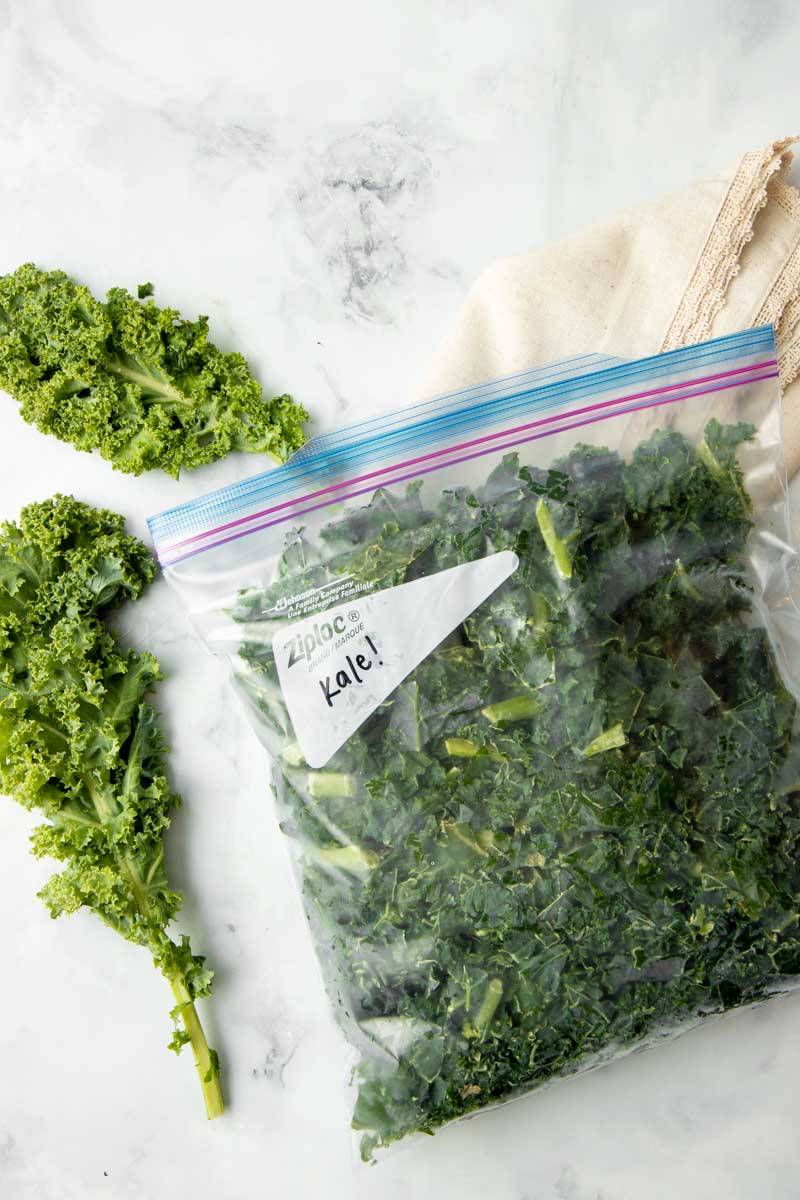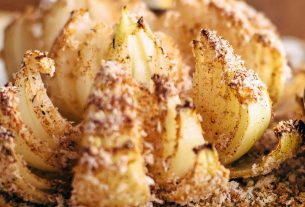Are you tired of wasting kale every time you buy it in bulk?
Well, worry no more!
We have the solution to all your kale-storing woes.
In this quick guide, we’ll teach you the art of freezing kale, unlocking a world of possibilities for your future smoothies, sautés, and soups.
Get ready to say goodbye to wilted greens and hello to long-lasting, nutritious goodness.
So, let’s dive in and discover how to freeze kale like a pro!
how to freeze kale
To freeze kale, blanch the leaves and stems for 2.5 minutes and 3 minutes respectively.
Then, place them in ice water for the same amount of time.
Dry the blanched kale by rolling it up in a towel and squeezing out excess water.
Next, quick-freeze small clumps of kale individually on a cookie sheet before transferring them to freezer bags.
Remove air from the bags and seal them tightly.
Alternatively, you can place blanched and dried kale into individual packages prior to freezing.
Frozen kale can be used in various dishes such as smoothies, sautés, quiches, stews, soups, and pesto.
Key Points:
- Blanch kale leaves for 2.5 minutes and stems for 3 minutes
- Place blanched kale in ice water for same amount of time
- Dry blanched kale by rolling in towel and squeezing out excess water
- Quick-freeze small clumps of kale on cookie sheet before transferring to freezer bags
- Remove air from bags and seal tightly
- Alternately, place blanched and dried kale into individual packages prior to freezing
how to freeze kale – Watch Video


Pro Tips:
1. Kale belongs to the Brassica family, which also includes vegetables like broccoli, cabbage, and Brussels sprouts.
2. Freezing kale can help break down its tough cell walls, making it more tender and easier to cook with.
3. When freezing kale, blanching it in boiling water for a couple of minutes before freezing helps preserve its color, texture, and nutrient content.
4. Frozen kale can be a versatile ingredient in recipes, including smoothies, soups, stews, and stir-fries.
5. Kale expands when frozen, so it’s important to leave enough headspace in the container or freezer bag to accommodate the expansion and avoid bursting or compromising the seal.
Freezing Kale Without Blanching And Bitterness
Freezing kale without blanching is a quick and convenient way to preserve this leafy green for longer. However, it’s important to note that not blanching kale may result in bitterness due to the presence of ripening enzymes in the leaves. These enzymes can continue to work even in freezing temperatures, affecting the taste and texture of the kale.
To avoid bitterness in frozen kale, blanching is recommended before freezing. Blanching involves briefly boiling the kale to inactivate these ripening enzymes, ensuring a better preservation of flavor and nutrients. While it may take a little extra time, the extra step is well worth it to enjoy the vibrant taste and texture of kale even after it has been frozen.
Using Unblanched Kale In Stews And Soups
If you choose not to blanch your kale before freezing, you can still make use of it in various dishes where the bitterness can be overpowered. Stews and soups are excellent options as the bold flavors and longer cooking times can help mask any bitterness. The kale will not only add a nutritional boost to your dishes but also contribute to their overall taste and texture.
When using unblanched kale in stews and soups, it’s important to remember that the bitterness may still be noticeable. To minimize this, try adding other ingredients such as acidic tomatoes, savory herbs, or spices to balance out the flavors. The longer cooking time will also help soften the leaves and reduce their bitterness.
Recommended Blanching Times For Freezing Kale
To ensure optimal freezing results, blanching kale before freezing is recommended. The blanching process involves briefly boiling the kale leaves and stems to deactivate the ripening enzymes that can cause bitterness.
For kale leaves, blanching them in boiling water for approximately 2.5 minutes is ideal. This will ensure the enzymes are sufficiently deactivated while still maintaining the kale’s vibrant green color and nutrients.
When it comes to blanching kale stems, a slightly longer blanching time of about 3 minutes is necessary. This extra time allows the heat to penetrate the denser stems and ensure proper enzyme deactivation.
These recommended blanching times are suitable for longer freezing periods, ranging from 8 to 12 months. By following these guidelines, you can preserve the flavor, color, and nutrients of the kale for an extended period.
Placing Blanched Kale In Ice Water After Blanching
After blanching your kale leaves and stems, it’s crucial to halt the cooking process and cool them down quickly. Placing the blanched kale in ice water for the same amount of time as the blanching helps retain the vibrant green color and crisp texture.
The ice water bath not only prevents further cooking but also helps to maintain the kale’s nutritional value. The rapid cooling process preserves valuable vitamins and minerals, including vitamin K, vitamin C, and folate.
Once the kale has soaked in the ice water bath, remove it and allow it to drain excess water. Properly draining the blanched kale ensures that it won’t become waterlogged and lose its texture when frozen.
Drying Blanched Kale Leaves On A Towel
After blanching kale, it is crucial to remove all remaining moisture before freezing it. This will help prevent the formation of ice crystals, which can cause freezer burn and affect the quality of the frozen kale.
To dry the blanched kale leaves, follow these steps:
- Lay the kale leaves out on a clean towel.
- Gently pat the leaves with another towel or paper towels to absorb any remaining moisture.
- Ensure that all excess water has been removed before proceeding to freeze the kale.
By effectively drying the blanched kale leaves, you can eliminate any excess moisture and achieve better texture and preservation when freezing.
Quick-Freezing Kale On A Cookie Sheet
To prevent the blanched kale from sticking together when frozen, it’s best to quick-freeze the leaves individually before transferring them to freezer bags. This method ensures that you can easily portion out the desired amount of frozen kale without dealing with clumps or chunks.
To quick-freeze the blanched kale, spread small clumps of leaves, ensuring they are not touching, on a cookie sheet lined with parchment paper. Placing them individually like this prevents them from freezing together into a solid mass.
Once the blanched kale is adequately spaced on the cookie sheet, place it in the freezer. Leave it there until the individual clumps are frozen solid, which usually takes a few hours. This quick-freezing step prepares the kale for long-term freezing without compromising its texture or quality.
- Spread small clumps of blanched kale leaves on a parchment-lined cookie sheet.
- Ensure that the leaves are not touching each other.
- Place the cookie sheet in the freezer until the leaves are frozen solid.
Removing Air From Freezer Bags Before Sealing
Before transferring the quick-frozen kale to the desired freezer bags, it’s essential to remove as much air as possible. Excess air can lead to freezer burn and negatively affect the quality of the frozen kale over time.
To remove air from the freezer bags, press gently on the bags to push out as much air as possible before sealing them. Alternatively, you can use a straw to suck out the air from a small opening in the bag before quickly sealing it.
Properly sealing the freezer bags without air gaps helps maintain the kale’s freshness and flavor when stored in the freezer.
Individually Packaging Blanched And Dried Kale
Another effective method for freezing blanched and dried kale is to package it individually. This option allows for easy portioning and resealing, eliminating the need to thaw and use the entire package at once.
To individually package the blanched and dried kale, place the desired amount in small freezer-safe bags or containers. Ensure that each portion is enough for a single serving or the amount you typically use in your recipes.
By packaging the kale individually, you can conveniently remove one portion at a time without defrosting the entire batch. This method helps reduce waste and keeps the kale fresh for longer periods.
- Package the kale individually for easy portioning and resealing
- Use small freezer-safe bags or containers
- Ensure each portion is enough for a single serving
- Conveniently remove one portion at a time without thawing the entire batch
- Reduces waste and keeps the kale fresh for longer periods.
Choosing The Right Size Freezer Bag
When freezing kale, it is important to choose the right size freezer bags. Opt for bags that will comfortably fit your desired serving-size portions. Using bags that are too large can lead to excess air being trapped, resulting in freezer burn and a loss of quality.
To make it easier to use the frozen kale in your recipes, consider freezing it in smaller quantities that are suitable for your needs. This way, you can easily remove the required amount without having to thaw and refreeze the unused portion repeatedly.
When selecting freezer bags, make sure they are made of durable and airtight material that is safe for freezing. It is also beneficial to choose bags that are specifically designed for freezing, as they ensure the best preservation of the kale’s flavor and quality.
- Choose the right size freezer bags that fit your serving-size portions comfortably
- Freeze kale in smaller quantities for easier use in recipes
- Select durable and airtight freezer bags made of safe material
- Opt for bags specifically designed for freezing to preserve kale’s flavor and quality.
Versatile Uses For Frozen Kale
Once frozen, kale becomes a versatile ingredient that can be incorporated into various dishes. Whether you enjoy its earthy flavors on their own or prefer to incorporate it into a recipe, frozen kale offers a convenient way to add a nutritional boost to your meals.
Frozen kale can be used in smoothies, adding a punch of nutrition to your favorite blends. Simply toss a handful of frozen kale leaves into the blender with your other smoothie ingredients, and enjoy the added vitamins, minerals, and fiber.
Another delicious way to use frozen kale is by sautéing it with seasoned rice vinegar or garlic. The kale will retain its vibrant green color and flavorful bite, making it a perfect side dish or a nutritious addition to stir-fries.
If you’re feeling adventurous, frozen kale can be added to quiches, stews, and soups. Its versatility allows it to complement an array of other ingredients, adding depth and texture to these dishes.
For those who love pesto, frozen kale can be an excellent substitute for traditional basil. Blending frozen kale with garlic, Parmesan cheese, pine nuts or almonds, and olive oil creates a nutrient-packed pesto. Use it as a sauce for pasta, spread on sandwiches, or as a garnish for roasted vegetables.
In conclusion, freezing kale can be done easily with a few extra steps to ensure the best preservation of flavor, color, and nutrients. Blanching the kale before freezing prevents bitterness caused by ripening enzymes and provides for a longer storage life. By following these guidelines, you can freeze kale and enjoy its benefits in a variety of delicious and nutritious dishes. So, next time you have an abundance of kale, make the most of it by freezing it properly and creating tasty meals all year round.
- Freezing kale preserves flavor, color, and nutrients
- Blanching kale before freezing prevents bitterness
- Frozen kale can be used in smoothies, stir-fries, soups, and quiches
- Frozen kale can be used to make nutrient-packed pesto.

You may need to know these questions about how to freeze kale
Can you freeze fresh kale without blanching?
Although blanching kale before freezing it is recommended to preserve its freshness and prevent a bitter taste, you can freeze fresh kale without blanching. However, it is important to note that frozen kale should be used within four weeks to ensure the best taste and texture. By skipping the blanching step, the kale may develop a slightly different taste and texture compared to blanched kale. Therefore, if you plan on using frozen kale for longer periods or prefer the taste of blanched kale, it is advisable to blanch it before freezing.
How do you freeze a bag of kale?
To freeze a bag of kale, start by rinsing the kale thoroughly and allowing it to drain completely. Once drained, transfer the kale into an airtight freezer-safe container. I personally recommend using freezer bags as they are convenient for storage, as they lay flat and take up minimal space in the freezer.
Does kale stay good in the freezer?
Yes, kale stays good in the freezer for up to six months. After flash freezing the dried kale on a baking sheet, it can be transferred to a labeled freezer-safe bag and stored for an extended period. Freezing preserves the quality and nutrients of kale, allowing you to enjoy its health benefits even after several months of freezing.
Can you blend kale then freeze it?
Yes, blending kale and freezing it can be a convenient way to preserve it. By pureeing the kale with water and using the juice cycle on a blender, you can create a concentrated kale mixture. This puree can then be poured into ice cube trays and frozen, allowing you to easily access and use smaller portions of kale for smoothies or other recipes. Freezing pureed kale in ice cube trays provides a practical solution for extending the shelf life of kale while maintaining its nutritional value and making it readily available for future use.
Reference source
https://www.hgtv.com/outdoors/gardens/garden-to-table/can-you-freeze-kale
https://soilborn.org/recipe/how-to-freeze-kale/
https://www.budgetbytes.com/how-to-freeze-kale/
https://www.allrecipes.com/article/how-to-store-kale/



